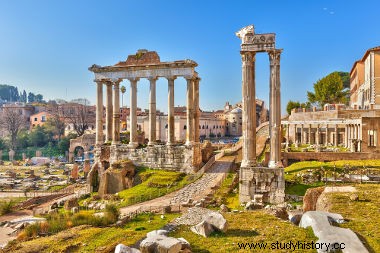
By Me. Cláudio Fernandes
The city of Rome , founded by the Latin peoples in the region of Lazio, in the Italian Peninsula, during almost the entire 7th century BC, was subject to the monarchy Etruscan. The Etruscans, peoples who also settled in the region of present-day Italy, began to exercise their power over the region of Lazio around 616 BC. with Tarquine Prisco. However, in the year 509 BC, the patricians – Roman citizens heirs of the ancient founding clans of the city – established the Republic through a coup d'état. The Republic , which means “public thing”, started to function on the basis of a sophisticated network of institutions.
The institutions of the Roman Republic were essentially commanded by the patricians. During much of the period in which the republic lasted, the plebs were relegated to the space of the tribunate, the Pplebe's Tribune , composed of members elected annually and which had the power to veto decisions concerning the interests of the commoners. Apart from that, the other institutions were occupied by patricians and had an interconnected and theoretically harmonious functioning.
In this context, there were the senators , the magistrates and the rallies. The rallies were responsible for electing magistrates and voting on laws. The magistrates, in turn, had the following functions:the convening of rallies, the presidency of the Senate and the elaboration of proposals for new laws. Finally, the Senate was given the task of proposing advice to the magistrates and approving the decisions taken within the scope of the rallies.
The main and most powerful institution of the Roman Republic was the Senate . The expression senate, which still persists within contemporary democratic institutions, comes from the Latin senex , , which means "sir", "old". The members who made up the senate were the oldest men from the traditional families of Rome. In all, there were 300 senators. Much of the power of the Ancient Roman Republic was concentrated in the senate.
In the context of the rallies, there was the Centuriate Assembly , which consisted of nineteen centuries, composed of patricians who were in charge of electing magistracy positions, such as the censors, that they were elected every five years and took care of the population census and tax collection; the blacks , responsible for the scope of justice; and, finally, by the constitution of the Assembly Curiata , who was responsible for annually electing the two consuls , responsible for the administration of public life and the command of the army. The Curiata Assembly was responsible for the eventual election of a dictator, in times of crisis, who would have a six-month mandate and absolute powers.
In addition, as the researcher Paulo Roberto Souza da Silva states, the “political institutions of the Roman Republic:the Senate, the colleges of magistrates and the rallies, ensured, for centuries, the legality, strength and efficiency of the State, in war and in peace. The social and economic changes caused by the success of the Punic Wars turned Rome into an empire, but with a simple city-state constitution .” [1]
NOTE
[1] SILVA, Paulo Roberto Souza da. Republican Institutions in the Roman Revolution. Alethéia Journal of Antiquity and Medieval Studies . Volume 2/2, Aug/Dec. 2010. p. 16.
Take the opportunity to check out our video lessons related to the subject:
